Summer time! Time for swimming, playing, relaxing, and…homeschool planning! Yay! I know homeschool planning may not be on the top of every homeschool mom’s fun-list for summer, but can I tell you a secret?
I actually love it.
I’m that geeky mom that really loves sitting down and planning out our homeschool year. I get all excited…
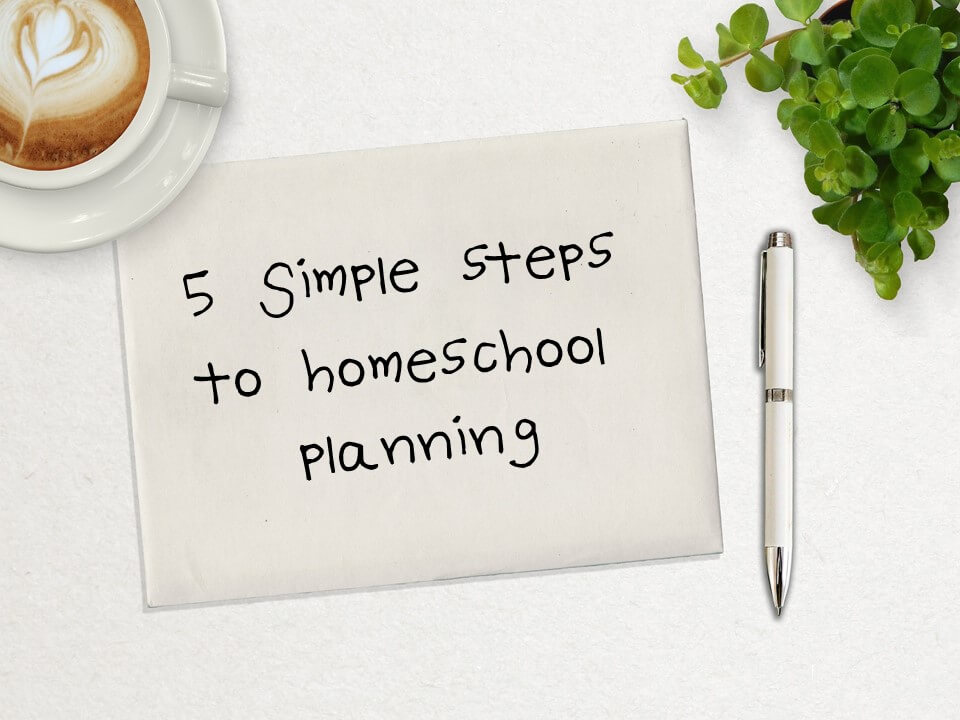
5 Simple Steps for Homeschool Planning
Seriously though, through the years I’ve developed a simple homeschool planning system that makes it so easy. Maybe that”s why I love it!
And I’ve learned that when I plan carefully and write out a map of how our school year should go, it makes our whole year flow smoothly! The perks? This way, I don’t have to worry about writing lesson plans each week or scrambling to pull a lesson together because I put in the hours over the summer planning it all out!
So, when I dedicate a good chunk of time each summer to homeschool planning I feel more calm, the kids know exactly what to accomplish, and everyone benefits!
It may sound daunting, but you can knock out all your homeschool planning for the entire school year over a few hours or days by following these 5 simple steps.
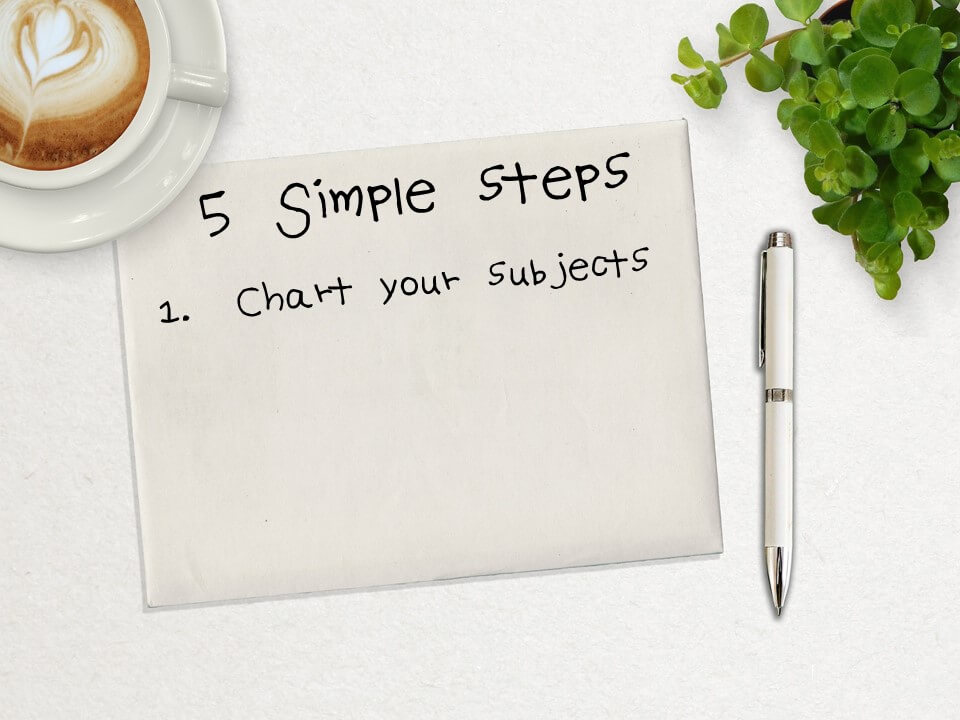
STEP 1: Chart your subjects
On my computer, I keep a very simple chart I use each year. You can download it here or draw your own on a piece a paper. It’s super easy! Down the left side I write the main subjects I need to cover for the year. Each child’s name goes in a column across the top.
The subjects I include are the basics:
- Math
- Language arts
- Science
- History (or social studies)
- Bible
- Electives (extras)
For language arts, I often break it down further into reading, writing, spelling, handwriting, and grammar, unless I am using an all-in-one language arts curriculum. In pre-k, kindergarten and 1st grade, our main focus is on learning to read and math so my kids may not cover the other subjects every day or at all in those grades.
Electives are simply the special extras that we do – the fun stuff – that may or may not be part of our actual school day. Electives are usually one of four categories: languages (like Spanish or Sign Language), fine arts (music, theater, dance, etc.), PE (fitness and sports activities), or life-skills (cooking, sewing, woodworking, gardening, auto repair, finance, etc.) They don’t need all four types of electives each year! We aim for 1 or 2 per year.
READ: Should I Homeschool? 10 Key Questions to Help You Decide
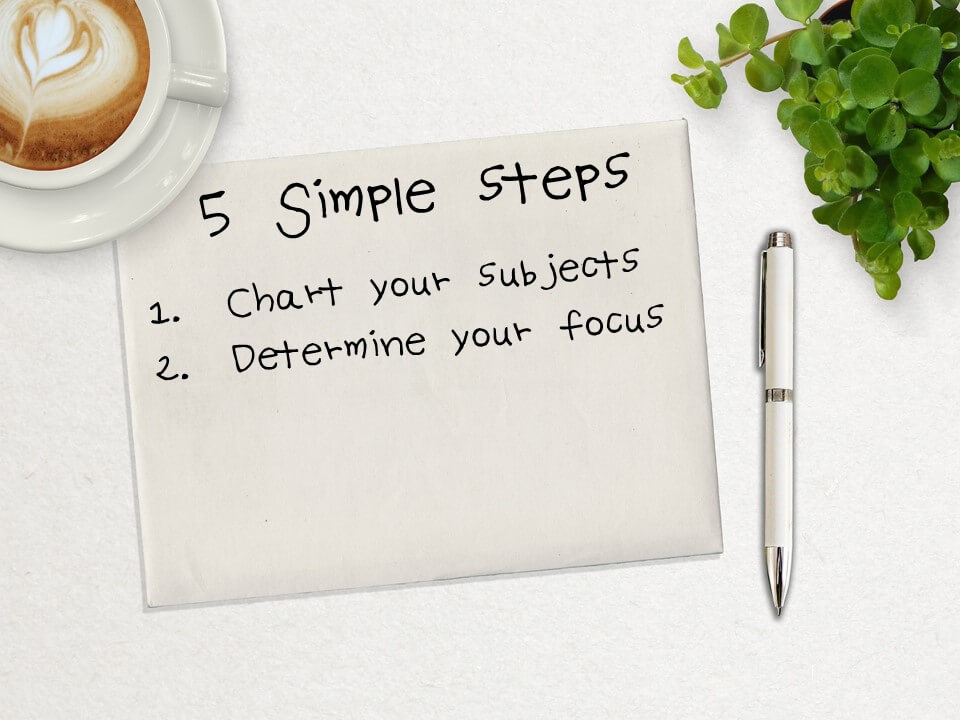
STEP 2: Determine your Focus
Using my chart, I fill it out by determining what the focus and curricula will be within each category for each child. How do you know what to teach? This is where a lot of parents new to homeschooling can get bogged down.
Read: Why I Homeschool My Kids
Back when I was a public school teacher, we followed the state guidelines, such as the TEKS in Texas, to know exactly what we should cover. School districts generally adopt a curriculum and so public school teachers are more or less told exactly what to teach and how to teach it each year, following a scope-and-sequence that provides an order for the year.
As a homeschool mom, we have a lot more flexibility and many more options available! Which can be wonderful, but can also be overwhelming and pretty confusing.
If you are using a certain curricula, such as Saxon Math or All About Reading, it will often have a specific order of books and materials so you know what to teach next for each grade level.
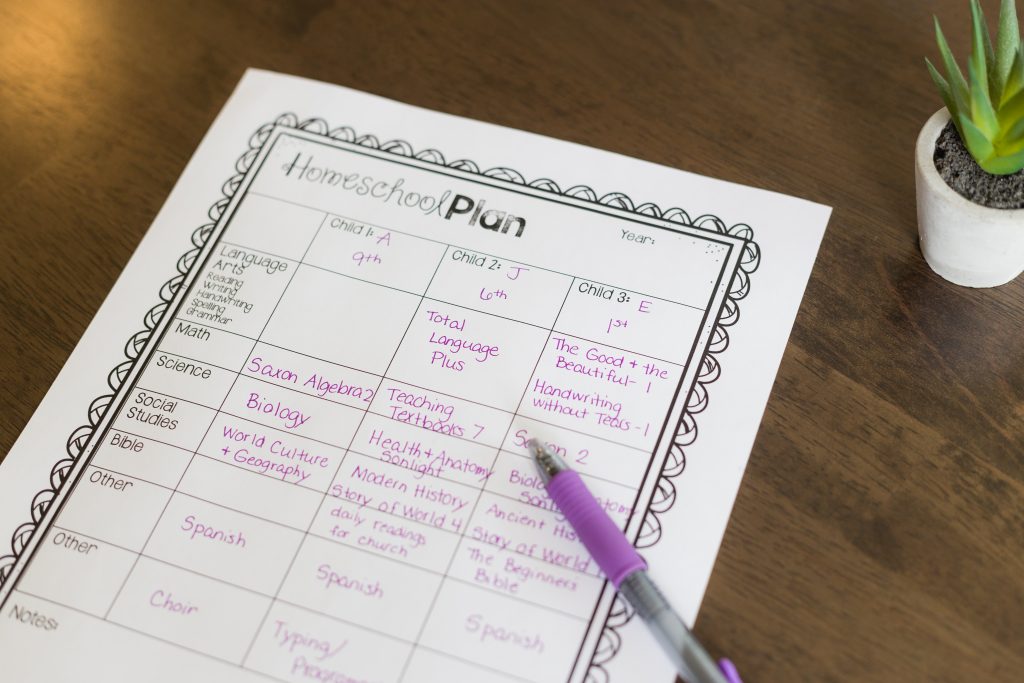
All-in-one Homeschool Kits
When I was new to homeschool, we used all-in-one curriculum kits like Sonlight. These kits can be flexible for students in multiple grade levels but cover language arts, social studies, science, and math all together. It includes weekly and daily lesson plans all laid out for you! We loved, loved, loved our years using Sonlight and it is a fabulous choice for families new to homeschool planning!
Another similar all-in-one curriculum that gets great reviews is My Father’s World. Even if an all-inclusive curriculum doesn’t sound like a good fit for you, it can be helpful to go to their website just to see what is covered in each subject at each grade level.
Want step-by-step preparing to homeschool? You got it! Grab a copy of my eBook or get a printed version shipped right to your home!
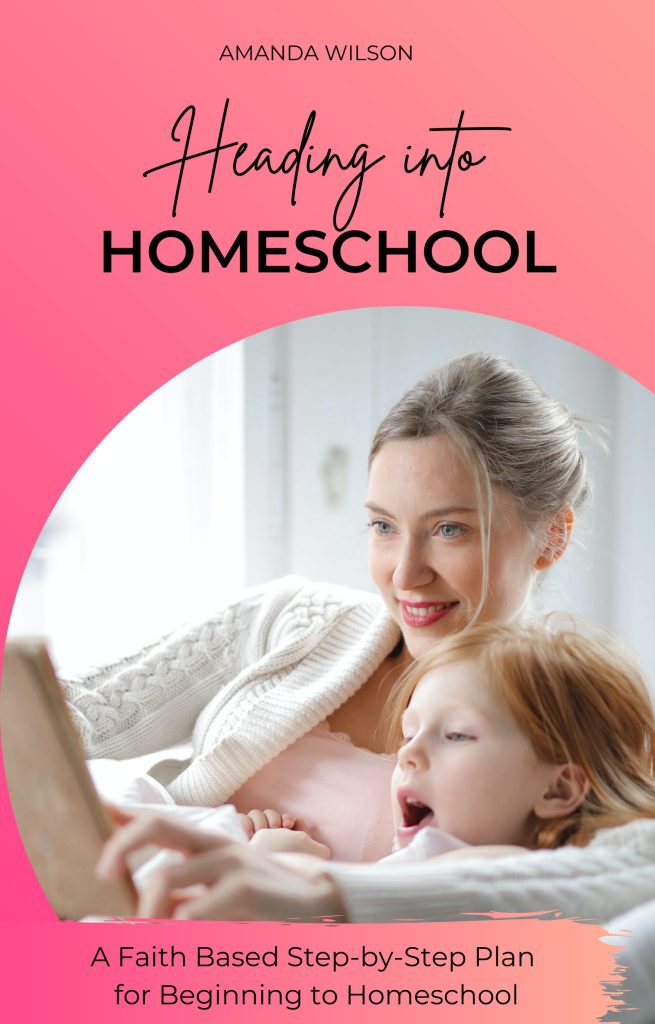
Individual Subject Homeschool Curricula
After a few years, my children needed different types of materials and greater flexibility, so we gradually moved away from the complete Sonlight package and began to piece-mail our homeschool curriculum subject by subject.
There are SO many homeschool curricula out there! A great place to go for reviews of homeschool curricula is Cathy Duffy’s Reviews.
Here’s a few that have become some of our favs through the years:
- Saxon Math (along with Nicole the Math Lady)
- Teaching Textbooks Math
- All About Spelling
- Story of the World history
- First Language Lessons for Grammar
- Sonlight Science
- Usborne books for Science
- The Good & the Beautiful language arts
- Handwriting Without Tears
Read: Phonics in Pre-K and Kindergarten
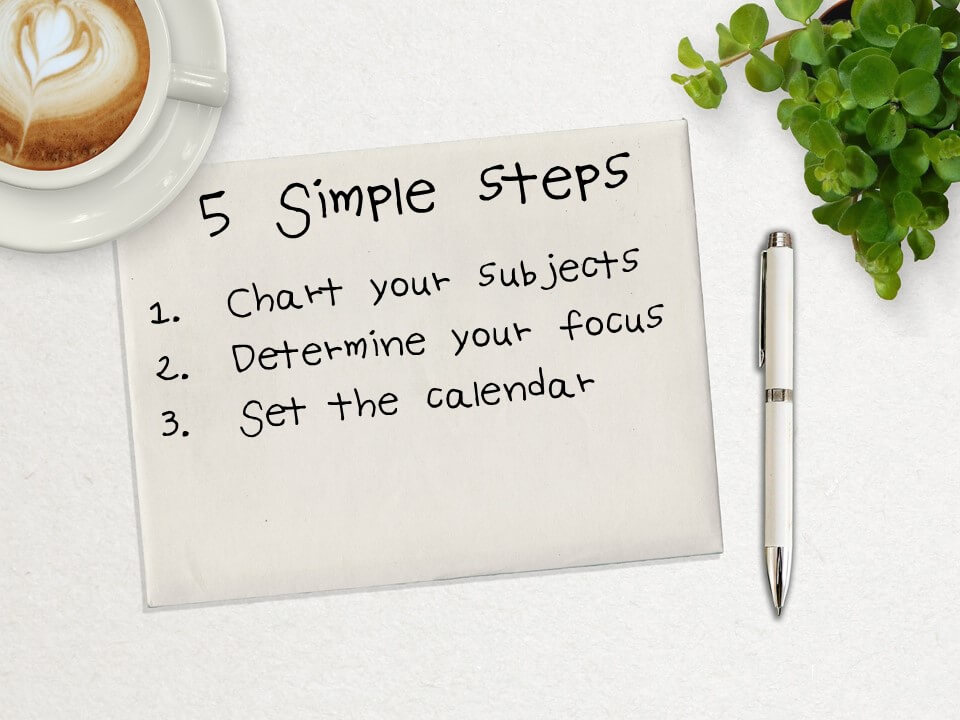
STEP 3: Determine your homeschool calendar
Did I mention one of the best things about homeschooling is flexibility? Yay! Some homeschool families school year-round, taking long breaks as needed or for extended travel. Others stick to a school schedule similar to public schools. One family we know schools during the spring, summer, and fall but takes the whole winter from November to January completely off for holidays and vacations.
Some states have strict guidelines for homeschoolers about required days of school and attendance. Others have no legal requirements at all. Before you plan, make sure to check your state’s requirements! But as a general rule of thumb, most curricula require 34-36 weeks of instruction to cover the material. For comparison, public schools often do 4 quarters of 9 weeks each, equaling 36 weeks total.
So your next step is to decide on your number of weeks and figure out on a calendar of when you plan to “do school”. In our family, we do 34 weeks of official school, 4 days a week and we more or less stick to a traditional school schedule.
We take summers off, but any extra content that we don’t complete, we do in tiny spurts and fits throughout the summer. Yep, I’m that mean mom that makes them do summer maintenance work. In summer, the kids do 20 minutes of reading and 20 minutes of math plus a bit of writing here and there. But this allows us to finish up any odds and ends of math lessons or material that needs review over the summer!
Especially when they’re little, kids tend to forget a lot of info over extended breaks if they don’t review it occasionally.
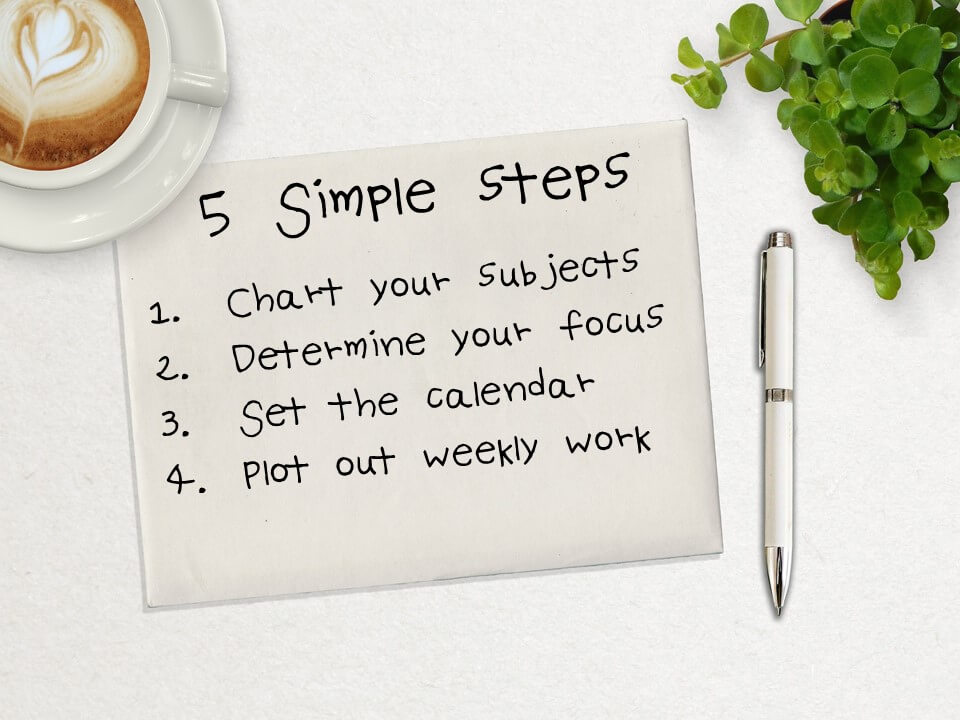
STEP 4: Plot out weekly work
Once you have chosen your curriculum and decided on the number of weeks and number of school days, you can quickly and easily plot out a schedule of what lessons need to be done each week. In the free download, there’s a chart already made for you.
For example, 34 weeks x 4 days = 136 days. Then you just divide the number of lessons in a book by the number of weeks you plan to do school.
I make another chart, one for each child this time. Down the left column, I number the 34 weeks. Along the top, I list each subject for that child. Under each subject, jot down the number of lessons in the book you plan to use. Remember: # lessons / # weeks = weekly workload.
For example, as I was plotting out The Good & The Beautiful level 1 lessons for my daughter next year, it shows there are 120 lessons. I divide 120 by 34 weeks of school and get 3.5. That tells me we need to complete 3 and a half lessons each week or complete 4 one week and 3 the next. So, I plot it out.
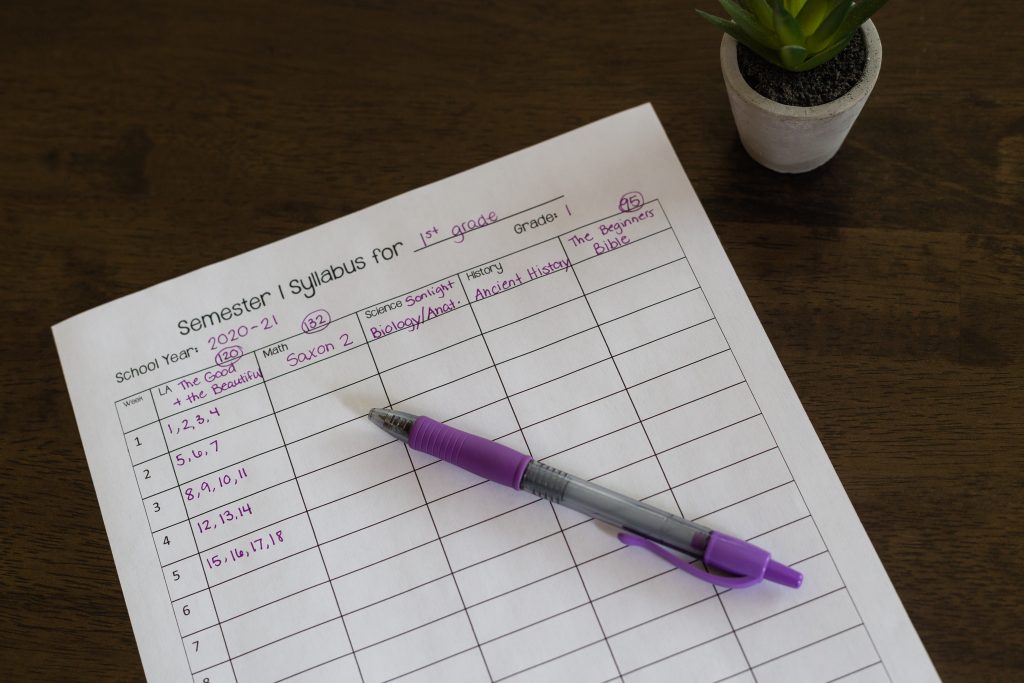
Take it One Step Further
You can leave it there as simple as that if you’d like! But I usually take it a step further and type up a syllabus of sorts for each child that keeps us on track all year. That way, we know exactly what we need to accomplish.
If someone is sick, we just scoot things around as needed and catch up or take a week off and add on an extra week at the end. The beauty of having a 4-day week is that we have at least 1 day “free” each week that we can use for catch up or sick days as needed.
Read: Top 10 Tips for New Homeschoolers
You don’t have to do every subject every day. Think college schedule. If you plan for 136 days of instruction and realize that there are only 100 lessons in a book, you may want to assign that subject only 3 days per week or you can choose to complete it as normal but finish up that subject early in the school year for a lighter finish to the year!
Yay for options!
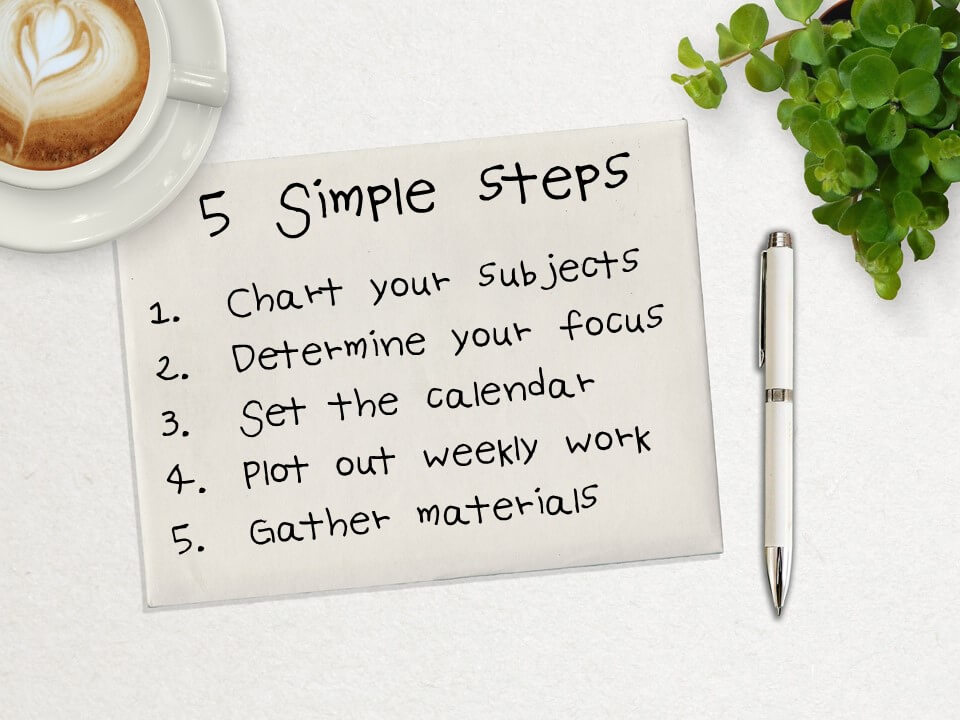
STEP 5: Gather Materials
Where do you find homeschool materials? Once you decide what curricula you want to use, searching for books for just the right price can be…totally fun!
Honestly, I love this part, too. Bargain hunting! Ebay stalking!
Let’s face it. Homeschooling can get expensive, especially with multiple children. So, we buy a lot of our books used. Here’s the low-down on where I look for books:
- Online direct from publisher – I usually start by looking up the price of the book straight from the publisher’s website so I know what it costs direct from them. Sometimes, they are running sales and have amazing prices on brand-new books!
- Amazon – check both new and used prices
- Ebay – can find both new and used texts. This is a great place to look for kits like Sonlight books or All About Spelling kits
- Facebook Marketplace or Facebook homeschool buy-sell-trade groups
- Homeschool Classifieds – a website where individuals can list books to sell and buy.
- Co-op Groups – if you’re part of a co-op, you can often swap materials or purchase used books from other families you know.
- Half-Price Books – I’ve scored some incredible finds at Half-Price books! You can frequently pick up Usborne Encyclopedias or Science books here.
- The Homeschool Store – If you’re in Texas, we have an amazing Homeschool Store in Houston that carries all the major homeschool textbooks both new and used. Y’all come visit!
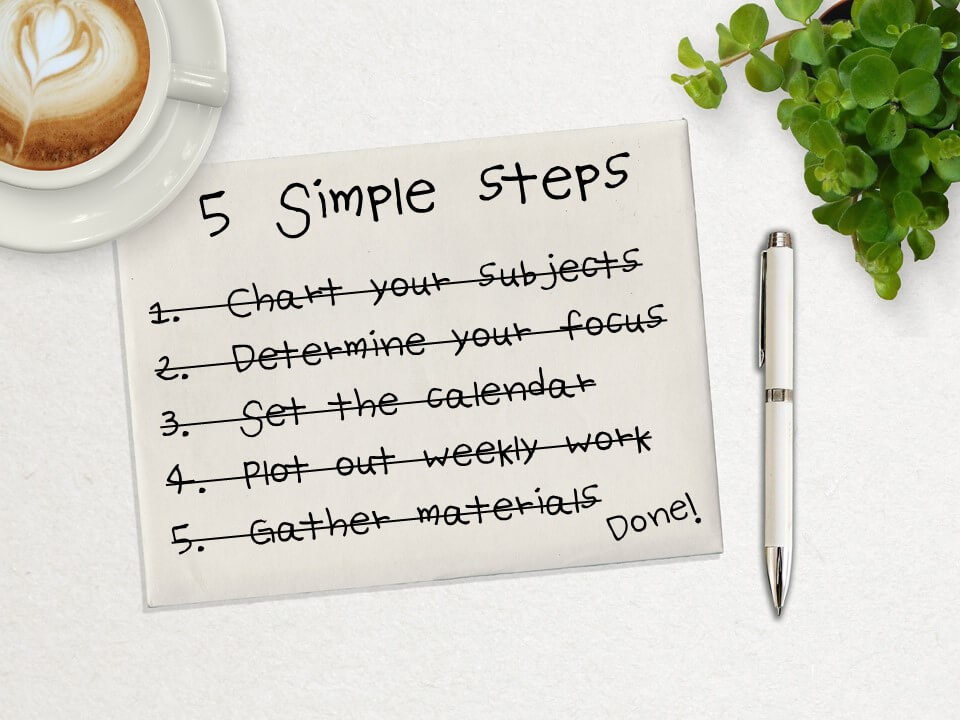
Homeschool Planning in the Bag!
And that’s it! Just 5 simple steps and your homeschool year is all planned out! Don’t forget to download the planning docs to help you out. Take the plunge this summer and plan out you’re homeschool year now. You’ll be glad you did!
[mailmunch-form id=”920953″]
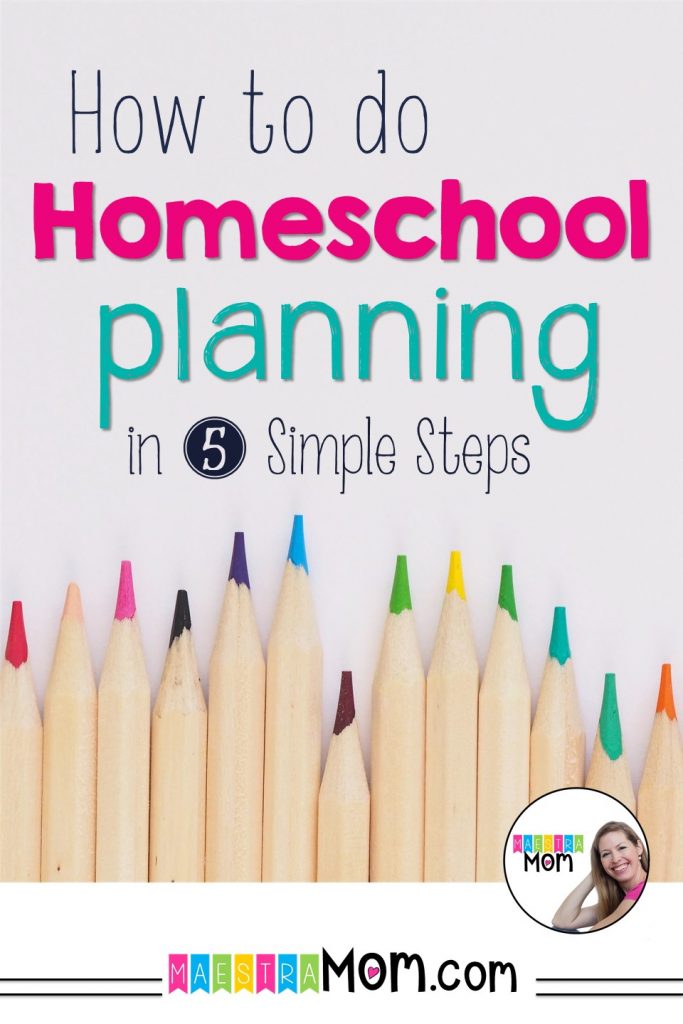


Pingback: Why I Homeschool My Kids - Maestra Mom - Why Choose Homeschooling
Pingback: Top 10 Social Emotional Picture Books for Kids - Maestra Mom
Pingback: Catch Up with MaestraMom - Maestra Mom - Where ya been?
Oh yes – this will become HUGE this fall I think as more students are transitioning to e-learning (here in Ontario anyway!). I don’t have kids but I think I would probably enjoy homeschooling! These are great tips!
Thanks, Sarah! So many families are having to seriously consider homeschooling these days. Thanks for the feedback!
The whole home school year planned out in a few days! Wow, this rocks!
Thanks! I sure hope it is helpful!
This is great although I have to admit that I am hoping not to be homeschooling this fall along with my full time job.
You are not the only one thinking that! But it’s great you landed here just in case, right?
I’m a planner too, down to the nth detail…love it! It drives my husband crazy when I am in planning mode for a trip, but he never complains when we have a spectacular adventure.
Sabrina,
Yay! A fellow planner! Makes life great on the other side, doesn’t it? Here’s to more adventures.
I get so overwhelmed with the planning portion. I wasn’t planning on homeschooling, but it may be what we end up doing this year.
Emily,
You’re not alone! I know many moms who are hoping their kids can go back to public schools this fall, but if not, I hope this helps take the scariness out of planning for home learning! Best wishes.
Planning out my year when I was teaching was so much fun! If we end up
Homeschooling this year I’ll use these tips to make my yearly plan. Thank you!
Stephanie, you are welcome! Hope it is helpful.
Wow, you made a confusing subject so much more digestible for me! I’ve been considering homeschooling for 6 years now, and this year even more with the pandemic. Thanks so much for sharing this!
This is so helpful! My little one only just turned 1 but I plan to homeschool her when it is time for it!
Kay,
So glad it was helpful! It’s never too early to start planning!
Such great tips!!! Getting that plan together to guide your year is essential AND makes for a successful year!! I always start my curriculum maps towards the end of July, too.
My hat is off to Homeschool Moms! WHOA! This is the one time that I’m so glad my kids are older through this time frame where everyone had to teach from home! I think I’d pull my hair out! Kuddos! to ALL the teachers out there!
Thanks, Barbara!
This was very informational. I know a lot of parents including myself may consider homeschooling due to the issues going on right now. Great article!!
Latoya,
I’m so glad you found it helpful! My heart goes out to all the parents and students struggling to adapt to new ways of learning through this pandemic!
Pingback: Should I homeschool? 10 Key Questions to Help You Decide - Maestra Mom